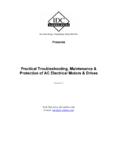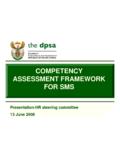Transcription of THE CEM BODY OF KNOWLEDGE AND STUDY GUIDE …
1 CEM Body of KNOWLEDGE & STUDY GUIDE Page 1 of 16 Version No: Approved by: Helen Johnson Approved on: 1/10/2019 Effective Date: 1/10/2019 Supersedes: Version Copyright 2019 Association of Energy Engineers. All rights reserved. THE CEM BODY OF KNOWLEDGE AND STUDY GUIDE Preparation for the CEM Certification Exam The CEM Certification Exam is a four-hour open book exam. The examination questions are based on the Body of KNOWLEDGE listed below. Because of the diversity of background and experience of Energy Managers, the examination has 15 different subject sections, all of which are included in the exam. You must bring a hand calculator to the exam as the CEM exam does not allow computers, tablets, or cell phones to be used during the test. It is highly recommended that you review the complete STUDY GUIDE and answer the Exam Review questions included in the STUDY GUIDE to determine your readiness for the exam.
2 The CEM Examination contains the following mandatory subjects: Body of KNOWLEDGE Percent of Exam Codes and Standards 3%-5% Energy Accounting and Economics 6%-10% Energy Audits and Instrumentation 8%-12% Electrical Power Systems and Motors 9%-13% HVAC Systems 9%-13% Industrial Systems 6% -8% Building Envelope 3%-5% CHP Systems and Renewable Energy 4%-6% Fuel Supply and Pricing 2%-4% Building Automation and Control Systems 7%-11% Thermal Energy Storage Systems 2%-4% Lighting Systems 6%-8% Boiler and Steam Systems 3%-5% Maintenance and Commissioning 8%-12% Energy Savings Performance Contracting and Measurement & Verification 3%-5% CEM Body of KNOWLEDGE & STUDY GUIDE Page 2 of 16 Version No: Approved by: Helen Johnson Approved on: 1/10/2019 Effective Date: 11/10/2019 Supersedes: Version Copyright 2019 Association of Energy Engineers.
3 All rights reserved. STUDY GUIDE CERTIFIED ENERGY MANAGERS (CEM EXAM) Online Self-Evaluation Exam Also Available CEM Applicants have access to an online version self-evaluation CEM exam. The 65-question multiple choice self-evaluation exam simulates half the certification test, contains a two hour time limit, and covers seventeen sections. There is a $50 fee to take this online test and you may access the full details at: Direct Link: Get a sense of how to time questions. The actual exam time allotted is 4 hours for 130 questions. You will need to complete the 65-question self-evaluation exam in 2 hours. At the end of the exam, you will receive a sections report that lets you know what sections you passed and failed. You will not be able to see the specific questions that you answered wrong/right or the answers.
4 The following is a list of the subjects for the CEM exam. Each subject covers a number of topics. Following the list of topics are suggested references with chapter numbers or sections. The primary references are the Handbook of Energy Engineering, 7th by D. Paul Mehta and Albert Thumann, the Energy Management Handbook, 9th Edition by Stephen Roosa, Steve Doty and Wayne C. Turner and GUIDE to Energy Management, 8th Edition by Barney L. Capehart, Wayne C. Turner and William J. Kennedy. However, some other books are also referenced as appropriate. The STUDY GUIDE will not lead you to answers to all of the questions, but it will certainly lead you to a very large number of correct answers. A person with the necessary experience who reviews the STUDY GUIDE should not have any problem passing the exam.
5 The exam will: be open book, last four hours, and have 130 questions to answer. Of the 130 questions, 120 are scored and 10 randomly located questions are trial questions being prepared for possible use on future exams. The 10 trial questions do not count toward the examinee s score. The trial questions are randomly located and are not identified. Therefore, all 130 questions should be answered. There are 15 sections listed below from which questions mainly are drawn. BODY OF KNOWLEDGE : STUDY GUIDE TOPICS & REFERENCES I. CODES AND STANDARDS *20XX stands for current year of standard ASHRAE/IESNA Standard ASHRAE Standard ASHRAE Standard -20XX ASHRAE Standard 135-20XX ASHRAE Standard 20XX ASHRAE Guideline 14-20XX ASHRAE Standard 211-20XX IEEE PQ Standard 519 International Energy Conservation Code (IECC) ISO 50001 Green Buildings Sustainable Design Certified, Silver, Gold, and Platinum Water Efficiency Materials and Resources ENERGY STAR Rating Energy Star Label LEED Certification Energy and Atmosphere Indoor Environmental Quality Portfolio Manager Green Globes ASHRAE Green GUIDE CEM Body of KNOWLEDGE & STUDY GUIDE Page 3 of 16 Version No: Approved by: Helen Johnson Approved on: 1/10/2019 Effective Date: 11/10/2019 Supersedes: Version Copyright 2019 Association of Energy Engineers.
6 All rights reserved. REF: Mehta and Thumann, Handbook of Energy Engineering, Chapter 1. REF: Roosa, Doty and Turner, Energy Management Handbook, Chapter 18 & 20. REF: ASHRAE 2004 and 2007 Standard REF: United States Green Building Council, website with LEED v3 and LEED Rating Systems presentations, REF: ENERGY STAR Building & Plants, ENERGY STAR website, REF: Capehart, Turner and Kennedy, GUIDE to Energy Management, Chapter 18 II. ENERGY ACCOUNTING AND ECONOMICS Simple Payback Period Time Value of Money Present Worth Net Present Value Present Worth Method After Tax Cash Flow Analysis Internal Rate of Return Energy Accounting Point of Use Costs Life Cycle Cost Method Interest Formulas and Tables Project Life Annual Cost Method Economic Performance Measures Depreciation Methods Impact of Fuel Escalation Rates Energy Reporting Efficiency Measures REF: Mehta and Thumann, Handbook of Energy Engineering, Chapter 2.
7 REF: Roosa, Doty and Turner, Energy Management Handbook, Chapter 4. REF: Capehart, Turner and Kennedy, GUIDE to Energy Management, Chapter 4. III. ENERGY AUDITS AND INSTRUMENTATION Role of Audits ASHRAE Level 1, 2, 3 Audit Audit Equipment Energy Management Measures Combustion Analysis Power Factor Basic Thermodynamics Air Velocity Measurement Light Level Measurement Infrared Equipment Fuel Choices Energy Use Index Load Factors Combustion Analyzers Electric Metering Temperature Measurement Pressure Measurement Humidity Measurement Energy and Power Measurement HHV and LHV Energy Cost Index Rate Structure & Analysis ASHRAE Standard 211-20XX Flow Measurement Heat Measuremet Behavioral Modification REF: Mehta and Thumann, Handbook of Energy Engineering, Chapter 3. REF: Roosa, Doty and Turner, Energy Management Handbook, Chapter 3.
8 REF: Capehart, Turner and Kennedy, GUIDE to Energy Management, Chapter 2. CEM Body of KNOWLEDGE & STUDY GUIDE Page 4 of 16 Version No: Approved by: Helen Johnson Approved on: 1/10/2019 Effective Date: 11/10/2019 Supersedes: Version Copyright 2019 Association of Energy Engineers. All rights reserved. IV. ELECTRICAL POWER SYSTEMS AND MOTORS Demand and Energy Real Power Power Factor Rate Structure and Analysis Variable Speed Drives Power Quality Grounding Load Factors Reactive Power Three Phase Systems Peak Demand Reduction Motors and Motor Drives Affinity Laws (Pump and Fan Laws) Harmonics AC Induction Motors DC Motors Load Factor and Slip Motor Speed Control Fan and Pump Laws Motor Selection Criteria Motor Management Software AC Synchronous Motors High Efficiency Motors Variable Frequency Drives Variable Flow Systems New vs.
9 Rewound Motors Electronically Commutated Motors REF: Mehta and Thumann, Handbook of Energy Engineering, Chapter 4. REF: Roosa, Doty and Turner, Energy Management Handbook, Chapter 11. REF: Capehart, Turner and Kennedy, GUIDE to Energy Management, Chapter 5 & 7. V. HVAC SYSTEMS Heating, Ventilating, and Air Conditioning (HVAC) Affinity Laws Psychrometric Chart HVAC Equipment Types Degree Days Heat Transfer Vapor Compression Cycle Cooling Towers Variable Refrigerant Flow Performance Rating (COP, EER, kW/ton) HVAC Economizers Air Distribution Systems (Reheat, Multizone, VAV) Chillers Energy Consumption Estimates Absorption Cycle Air and Water Based Heat Flow Demand Control Ventilation Smart Pumps Chilled Beam Systems REF: Mehta and Thumann, Handbook of Energy Engineering, Chapter 7 & 8. REF: Roosa, Doty and Turner, Energy Management Handbook, Chapter 10.
10 REF: Capehart, Turner and Kennedy, GUIDE to Energy Management, Chapter 8. VI. INDUSTRIAL SYSTEMS Waste Heat Recovery Industrial Energy Management Steam Systems Heat Exchangers Turbines Compressed Air Systems Air Compressor Controls Boilers and Thermal Systems Fuel Choices Steam Tables Compressors Pumps and Pumping Systems CEM Body of KNOWLEDGE & STUDY GUIDE Page 5 of 16 Version No: Approved by: Helen Johnson Approved on: 1/10/2019 Effective Date: 11/10/2019 Supersedes: Version Copyright 2019 Association of Energy Engineers. All rights reserved. Air Compressors Air Leaks Prime Power options Peaking Power options District Heating Systems REF: Mehta and Thumann, Handbook of Energy Engineering, Chapter 5, 6 & 12. REF: Roosa, Doty and Turner, Energy Management Handbook, Chapter 5, 6 & 8.






